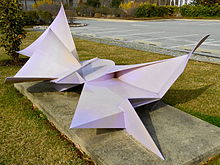Isaac Witkin
| Isaac Witkin | |
|---|---|

Wild Iris, 1974, at the Delaware Art Museum
|
|
| Born | May 10, 1936 |
| Died | April 23, 2006 (aged 69) Pemberton, New Jersey |
Isaac Witkin, internationally renowned modern sculptor, was born in Johannesburg, South Africa on 10 May 1936, and he died 23 April 2006. Witkin entered Saint Martin's School of Art in London in 1957. Studying under Sir Anthony Caro and alongside other luminaries in training such as Phillip King, William G. Tucker, David Annesley and Michael Bolus, Witkin learned and helped create a new style of sculpture that led to their being called the New Generation of sculptors when their innovating abstract forms of modern sculpture reached and changed the art world. Witkin's work, abstract works of usually brightly colored fiberglass or wood, in particular was noted for its "witty, Pop-Art look".
After graduating from Saint Martin's in 1960, Witkin was an apprentice of Henry Moore until 1963. Witkin's work was well received in his first solo show at Rowan Gallery, London and in an important 1964 show at Whitechapel Gallery, also in London, where Witkin and his fellow Saint Martin's "New Generation" sculptors made their big entry into the English art world. In 1965 his work received a first prize in the Paris Biennale. His piece, "Nagas", was included in the seminal 1966 exhibit, "Primary Structures" at the Jewish Museum in New York representing the British influence on the "New Art" anchored by Anthony Caro.
Witkin then moved from pupil to teacher, teaching at Saint Martin's for two years. He then moved to the United States. At Bennington College, Bennington, Vermont, Witkin worked with a community of artists known as "the Green Mountain boys" who either taught at the school or were part of the local arts community, including notables such as painter Kenneth Noland, Helen Frankenthaler, Larry Poons, Paul Feeley and Jules Olitski and art critic Clement Greenberg.
...
Wikipedia
